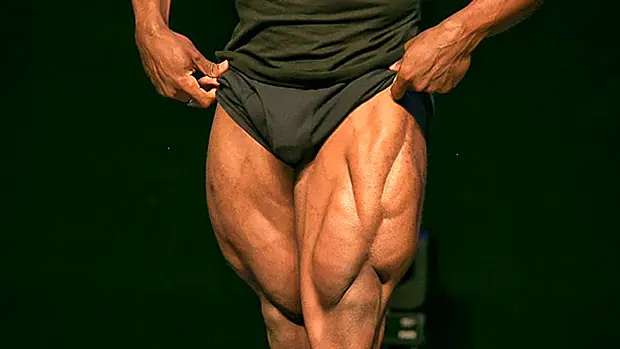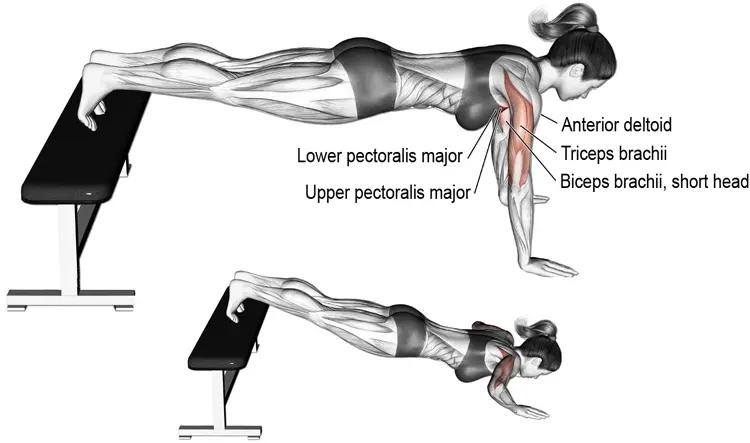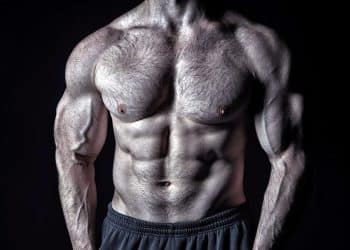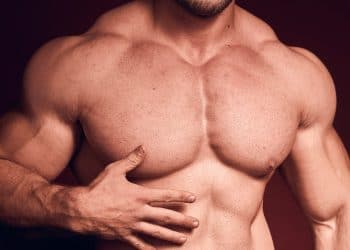Bodyweight workouts are all that many of us have right now until gyms open back up. We can’t afford to lose our hard-earned gains but at the same time, it can be a challenge to find the motivation to keep going.
But that’s where knowledge is king. If you know which exercises can offer the best bang for your buck, you’ll be more confident in your workouts. So, you won’t feel as if you’re wasting your time and spinning your wheels.
And with this 13-minute bodyweight-only workout, excuses are impossible as there’s very little time commitment. If you want a challenge, then try out this routine…
Note: This workout is ideal for more intermediate to advanced exercisers due to the nature of each exercise. You’ll also need to have decent cardiovascular fitness.
Also, this routine focuses on the major muscle groups only (no core exercises either). We did not include arms/smaller muscles which naturally assist in these exercises.
But it’s always a good idea to throw in some isolation work during the week too. It’s also important to note that this workout is ideal when you need to get something in and are pressed for time. It’s by no means a replacement for a more complete training routine but it’s effective nonetheless.
Level Up Your Fitness: Join our 💪 strong community in Fitness Volt Newsletter. Get daily inspiration, expert-backed workouts, nutrition tips, the latest in strength sports, and the support you need to reach your goals. Subscribe for free!
Although, you could just do it as a challenge to yourself anytime.
13 Minute Bodyweight Workout
This 13-minute workout is designed to be performed in a circuit type fashion. So, you’ll do one exercise and then move on to the next. Each set will last 10-30 seconds and you’ll perform each exercise at a moderate to quick tempo to ensure you get in enough reps.
You’ll rest 10-45 seconds between sets depending on the exercise (or not at all) and you’ll rest 30 seconds to a minute before you move onto the next muscle group, to maintain the intensity. Make sure you know how to perform each exercise correctly before starting the workout. We’ve provided the exercise duration and rest times below.
Also, don’t forget to take a few minutes and do a warm-up activity to get your heart rate up for the workout (e.g. brisk walk, jog, jump rope, burpee, etc). The workout is performed rather quickly so you want to feel good while doing it and not have your heart rate shoot up too quickly. Plus, you’ll prevent injury and feel the exercises working much better.
Ready… go!
Legs Workout
The main leg muscles include the quads, hamstrings, glutes, and calves. Therefore, we chose compound movements that work all of the main muscles of the lower body.

Make sure to do at least two warm-up sets of normal bodyweight squats before doing single-leg squats which are the first exercise in the workout. This is important for avoiding knee pain and feeling tension on the muscles rather than the joints.
1. Single-leg squat (15 seconds each side/30 seconds total)
The single-leg squat is a popular bodyweight exercise. The reason being is that it challenges you much more than a basic, two-legged squat. You can do this exercise without holding onto anything if you have good balance. However, to ensure you get in enough reps, we recommend gently gripping something for optimal balance.
A good way to do this is to stand in a doorway and lightly grip the sides of the door frame. This is also recommended because it allows you to place your feet a little farther forward to squat through the heels and protect the knees.
To do it:
- Gently hold onto the sides of a door frame while standing in the center, or try without.
- Place one foot flat on the floor a foot or so in front and lift the other leg up in front of you extended.
- Squat down until your upper leg is slightly below parallel to the floor.
- Drive through your heel back up to the top and repeat for reps then switch sides.
Rest 20 seconds and then do the Bulgarian split squat.
2. Bulgarian split squat (10 seconds each side/20 seconds total)
The Bulgarian split squat is a superior leg exercise that works the quads, hamstrings, and glutes. You should rep this one out quickly to get in as many reps as you can since you only have 10 seconds per leg.
To do it:
- Place the top of one foot on a chair or any similar elevated platform.
- Move the other leg out a few feet in front of you so that your shin is vertical.
- Squat down until your upper leg is below parallel to the floor and then drive through your heel back to the top.
Rest 45 seconds then move on to the next body part (chest).
2. Chest Workout
The main target muscle when training the chest is the pectoralis major which makes up the bulk of the appearance of the chest. Although, the pec minor (sits beneath major) still receives stimulation from typical chest exercises. These variations are as good as it gets for bodyweight chest development.
1. Decline inner-pec push-ups (15 seconds)
The inner-pec push-up is the answer to a more difficult variation when all you have is your own bodyweight. Combine it with your legs elevated to emphasize more if the upper chest and you’ll have one heck of a challenge. But exercise difficulty is what builds muscle.

The higher you elevate your feet, the more challenging this exercise will be. And believe us when we tell you that it’s a tough movement.
Level Up Your Fitness: Join our 💪 strong community in Fitness Volt Newsletter. Get daily inspiration, expert-backed workouts, nutrition tips, the latest in strength sports, and the support you need to reach your goals. Subscribe for free!
To do it:
- Place your hands on the floor and then elevate your feet up onto a platform of your choice (e.g. a chair, bed, counter, etc).
- Adjust your hands to be near mid-chest level and keep them about shoulder-width apart.
- Maintain a neutral torso, retract your shoulder blades, and tuck your elbows slightly.
- Lower yourself down to within an inch or two from the floor.
- Then instead of pressing up using both arms, focus on pressing more through one arm and rotate your torso toward that arm at the same time (you’ll be facing that arm). This will allow you to get a much better chest contraction than a basic push-up. Not to mention, you’ll have more weight to push which means you can build more muscle.
Immediately transition into the bodyweight fly.
2. Bodyweight sliding flys (15 seconds)
No equipment to do flys? No problem. You can do this exercise using your own bodyweight but you will need something that’ll slide on your floor. There are several ways to do this, however. You can use moving sliders, cloths, rags, socks (wear them on your hands) paper towels or anything else you can think of.
To do it:
- Get into a push-up position with something underneath your hands that’ll slide across the floor.
- Open your arms and allow your chest to come within an inch or two from the floor. Keep your elbows slightly bent.
- Pull your hands in together while contracting your chest muscles.
- Repeat.
Rest 45 seconds then move on to the next body part (back)
3. Back Workout
The back consists of several muscles that we’ll be working with our exercises of choice. These muscles include the rhomboids, erector spinae, trapezius, and latissimus dorsi. But the rear delts are also involved in this movement to a degree.
1. Elbow lifts (15 seconds)
Elbow lifts are one of the best bodyweight back exercises that requires nothing other than you. It works more of the upper back muscles and traps which is exactly what we’re aiming for here.
To do it:
- Lie on your back and bend your elbows.
- Tighten your core and then drive your elbows through the ground to lift your upper body as high as you can.
- Lower yourself and repeat.
Immediately do the bodyweight pullover.
2. Bodyweight pullover (15 seconds)
This exercise is the equivalent of a pullover which is an excellent movement for targeting the lats. You will need to be able to slide your knees or feet, so do it on a surface that’ll allow you to do so while wearing clothing or socks. Otherwise, you can place something under your knees or feet so you can slide better.
To do it:
- Get into a push-up position on your knees or toes depending on your experience level.
- Maintain a neutral torso and tighten your core.
- Push yourself backward until you feel a stretch in your lats.
- Pull yourself forward while flexing your lats until your chest is over your hands.
Rest 30 seconds then move on to the next body part (shoulders)
4. Shoulders Workout
The shoulders have three heads which include the front, middle, and rear. The front deltoid is often worked plenty when doing a good amount of pressing exercises. So because you’ll do a push-up and fly in this workout which activates the front delts, we’re only going to do an exercise for the middle and rear delts in this routine.
1. Bodyweight side raise (15 seconds each side/30 seconds total)
The bodyweight side raise is the best way to train the lateral or middle head of the deltoids when you don’t have access to weights. You’re simply rotating your body into and away from your arm while your forearm supports your bodyweight. This functions the same as a lateral raise but just in reverse.
To do it:
- Get into a plank position. You can do this on your knees or on your toes depending on your level of experience.
- Rotate your torso in toward either side and lift the non-supporting arm off the floor. You should feel a stretch in your deltoid.
- Now rotate your torso in the opposite direction until you’re in a side plank position.
- Complete the desired number of reps then switch sides and repeat.
Rest 30 seconds before doing the reverse iron cross.
2. Reverse iron cross (15 seconds)
This last exercise is perfect for working the rear delts using your own bodyweight. A large number of exercisers don’t do enough rear delt or posterior work in general. Therefore, we feel this exercise is a must. It’s not easy but your rear delts will be really working hard here.
To do it:
- Lie on your back and extend your arms out to your sides to form a cross.
- Make a fist with both hands then push through them into the ground while using your arms as well to lift your upper body up until your elbows leave the floor.
- Return to the original position then repeat.
Rest 1 minute and then do one more round of the workout.
FAQs
Can you build size with bodyweight-only workouts?
You sure can if the exercises are challenging enough. Fortunately, the exercises we’ve chosen for this 13-minute workout are among the most difficult.
Keep in mind though, after a certain level of training experience, bodyweight-only workouts will become less effective for muscle and strength-building purposes.
Can you burn fat doing bodyweight circuit training?
Absolutely! If you’re training with enough intensity and minimizing rest times in between sets, you burn a lot of calories which is necessary for weight loss.
But remember, you have to burn more calories than what you consume overall to experience consistent weight loss.
What are the most effective bodyweight exercises?
There are many but a few of the most challenging that’ll yield great results for most people include…
- Single-leg squats
- Bulgarian split squats
- Decline inner-pec push-ups
- Bodyweight flys
- Elbow lifts
- Bodyweight pullovers
- Bodyweight side raise
- Reverse iron cross
Are bodyweight exercises safer than weight training?
Not necessarily. In fact, bodyweight exercises can be just as dangerous if you do too much too quickly at first or if you have bad form.
Every exercise should be treated as a serious movement that needs to be performed with correct form.
Wrapping Up
13 minutes… that’s all it takes to get a decent workout that’ll target every major muscle group. It’s by no means a complete workout regime. But when you only have minutes to get something challenging in while leaving nothing out, it fits the bill perfectly.
And what’s special about this workout is that each exercise is among the best bodyweight options available. So rather than doing pointless exercises for endless reps, we’ll really push it and reap the benefits as a result.








